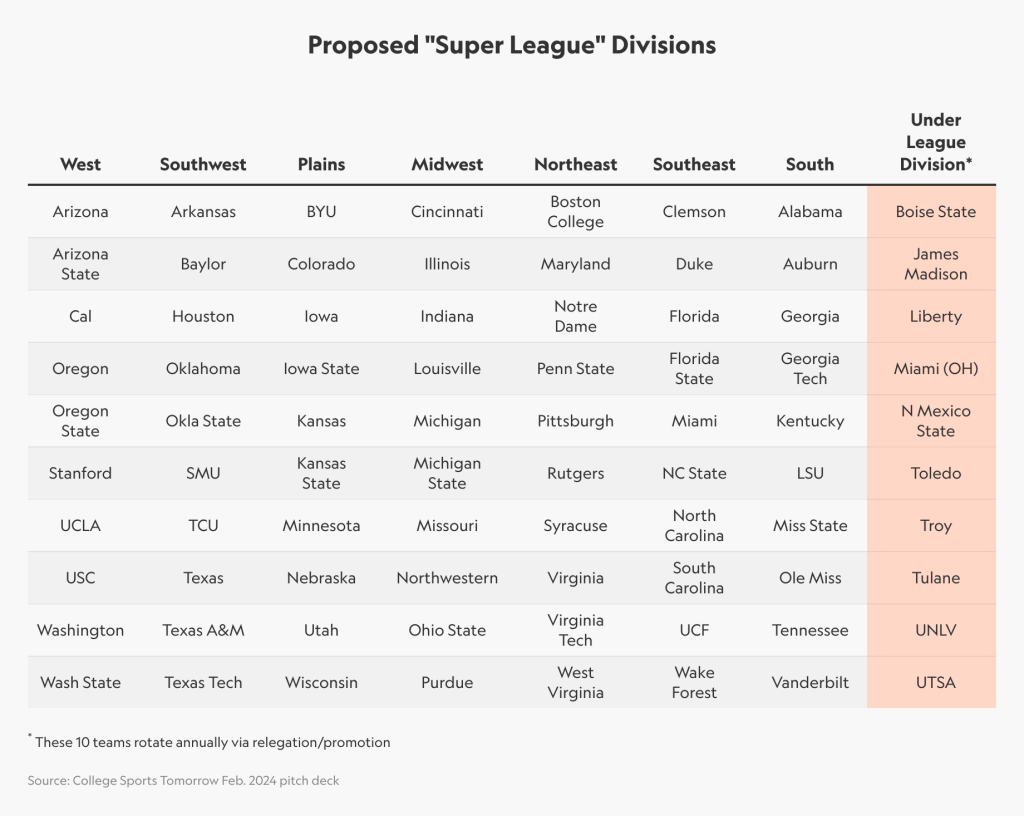The future of college football is in flux, with the current state of NIL and the transfer portal unsustainable. This problem affects not only the athletic directors, coaches, and players but also the fans of a sport rapidly losing its trademark tradition and parity.
According to College Sports Tomorrow, a 20-person group that includes Syracuse chancellor Kent Syverud, West Virginia president Gordon Gee, and NFL chief media and business officer Brian Rolapp, among others, the answer is a College Football Super League. How would such a framework be implemented?
College Football Super League Proposal Details Emerge
When The Athletic’s Andrew Marchand and Stewart Mandel first reported the idea at the beginning of April, we discussed the details available and provided our own amendments to make the design more appealing.
However, Sportico obtained the “confidential” pitch deck used by CST in their meetings with conference leaders in February.
Here is what became public through Marchand and Mandel:
- The league would be comprised of 70 “permanent” members — every program in the Power Five conferences, as well as Notre Dame.
- The top 70 would be placed into seven 10-team divisions, with an eighth formed out of teams that would be “promoted from the second tier.”
- The remaining 50+ Group of Five teams would be allowed to play their way into the eighth division, similar to the promotion system implemented in European soccer leagues.
- The 70 permanent teams would not be in danger of moving down, but the rest of the FBS programs would have the “incentive of promotion and relegation.”
- The playoffs would constitute the eight division winners and eight wild cards from the “top tier” (the top 70 teams), eliminating the need for a selection committee.
And here are the previously unreported details released by Sportico:
- Broadcast NIL (BNIL): Players would receive pro rata shares of a collectively bargained “FB Player Pool,” which would come from the league’s TV revenue.
- 5% would go to all rostered freshmen, 15% to sophomores, 30% to juniors, and 50% to seniors/graduate students.
- A “NIL Roster Cap” would be introduced, requiring individual NIL payments at a single school to be less than those earned through the group licensing/BNIL deals.
- Exceeding the cap in a season would be punished with the loss of transfer and scholarship slots.
- Falling under 80% of the pre-established “NIL Roster Floor” for two consecutive seasons would relegate the program to the Tier 2 league.
- The regular season would consist of 14 games (one bye week), beginning in August and ending on Thanksgiving weekend. There would then be a 16-team playoff played over five weeks, which could be expanded to 24 teams without increasing weeks played.
- A “college football spring festival” would comprise 40 spring games played by Tier 1 programs every April. Concerts and other events would be included, commercializing the spring portion of the schedule.
- Each team would have 85 roster spots with a maximum of 70 scholarship players.
- A minimum of 50 must be players recruited by the program from high school.
- Players can transfer twice within a five-year legibility window.
- Two transfer portal windows each year with a maximum of 10 additions per team for each one.
- An “open” window in February and a “supplemental” one in March.
- Schools would have to make “player transfer payments” to an athlete’s former program for acquisitions made in the open window.
- An “open” window in February and a “supplemental” one in March.
While all of that is interesting and paints a clearer picture of how a College Football Super League could be implemented, most fans want to know how the divisions would align.
Below are the proposed divisions from the pitch deck, with the 70 “permanent” programs being split into seven 10-team divisions based on geographic location: west, southwest, plains, midwest, northeast, south, and southeast.
The eighth division would rotate each season, with eight of the 10 teams replaced by schools playing their way up from the Tier 2 league (basically the Group of Five). The “Under League,” as the deck calls it, would comprise eight seven-team divisions, but they were not listed.

The proposal is centered around a 2027 launch date, which is optimistic, to say the least. CST met with the ACC board of directors in February, but their planned dinners with the Big Ten, SEC, and Big 12 all fell through due to the conferences not wanting to upset their current broadcast partners, namely ESPN and FOX.
But let’s say every conference and school did buy in. They are locked into billion-dollar TV deals with ABC, FOX, NBC, and CBS, and the FBS just agreed to a six-year, $7.8 billion extension with ESPN for exclusive rights to the newly expanded College Football Playoff.
KEEP READING: College Football Super League: The CFN 136-Team Proposal
The Big Ten’s contract runs through the 2029-30 season, the Big 12’s through 2023-31, and the SEC’s through 2033-34. So, if this College Football Super League came to fruition, it likely wouldn’t happen until the early 2030s.
College football, as we know it, is dead, but that doesn’t mean it can’t rise out of the ashes, improved and better suited for the new era. Is a College Football Super League the answer? It may not be the best one, but the proposal pushes the sport toward much-needed sustainability — and it’s running out of time.
College Football Network has you covered with the latest news and analysis, rankings, transfer portal information, top 10 returning players, the 2024 college football season schedule, and much more!

